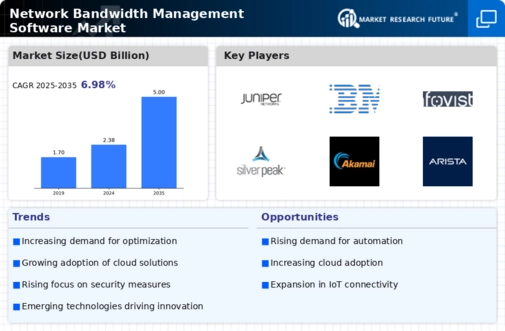Rising Internet Traffic
The Network Bandwidth Management Software Market is experiencing a surge in demand due to the exponential increase in internet traffic. As more devices connect to the internet, the need for efficient bandwidth management becomes paramount. Reports indicate that global internet traffic is projected to reach 4.8 zettabytes per year by 2025, necessitating advanced software solutions to optimize bandwidth allocation. This trend is driven by the proliferation of streaming services, online gaming, and remote work, all of which require substantial bandwidth. Consequently, organizations are increasingly investing in bandwidth management software to ensure seamless connectivity and enhance user experience. The ability to monitor and control bandwidth usage effectively is becoming a critical factor for businesses aiming to maintain operational efficiency in a data-driven environment.
Shift Towards Remote Work
The Network Bandwidth Management Software Market is witnessing a shift towards remote work, which has fundamentally altered bandwidth requirements. As organizations embrace flexible work arrangements, the demand for reliable and high-speed internet connectivity has intensified. This shift necessitates the implementation of bandwidth management solutions to ensure that remote employees have access to the resources they need without compromising network performance. Studies indicate that companies are investing more in bandwidth management software to support remote collaboration tools and applications. The ability to prioritize bandwidth for critical business functions while managing overall network performance is becoming increasingly vital. This trend is expected to continue as remote work becomes a permanent fixture in many organizations.
Emergence of 5G Technology
The Network Bandwidth Management Software Market is poised for growth with the emergence of 5G technology. The rollout of 5G networks is set to revolutionize connectivity, offering significantly higher speeds and lower latency. This advancement will lead to an increase in bandwidth demand as new applications and services emerge, such as augmented reality, virtual reality, and advanced telecommunication services. Organizations will require sophisticated bandwidth management solutions to optimize the use of this enhanced capacity effectively. The anticipated growth in 5G subscriptions, projected to reach 1.7 billion by 2025, underscores the necessity for robust bandwidth management strategies. As businesses adapt to this new technological landscape, the demand for effective bandwidth management software is likely to escalate.
Growing Adoption of IoT Devices
The Network Bandwidth Management Software Market is significantly influenced by the growing adoption of Internet of Things (IoT) devices. As industries integrate IoT solutions, the number of connected devices is expected to exceed 75 billion by 2025. This proliferation of devices generates vast amounts of data, leading to increased bandwidth consumption. Organizations are compelled to implement bandwidth management software to handle the complexities associated with IoT traffic. Effective bandwidth management ensures that critical applications receive the necessary resources while preventing network congestion. The rise of smart cities, connected vehicles, and industrial automation further underscores the necessity for robust bandwidth management solutions, as these applications demand reliable and efficient network performance.
Need for Enhanced Network Security
The Network Bandwidth Management Software Market is also driven by the increasing need for enhanced network security. As cyber threats become more sophisticated, organizations are prioritizing the protection of their networks. Bandwidth management software plays a crucial role in identifying and mitigating potential security risks by monitoring traffic patterns and detecting anomalies. The Network Bandwidth Management Software Market is projected to reach 345 billion USD by 2026, highlighting the importance of integrating security measures within bandwidth management solutions. By ensuring that bandwidth is allocated to secure applications and services, organizations can safeguard sensitive data and maintain compliance with regulatory standards. This focus on security is likely to propel the demand for advanced bandwidth management software in the coming years.


















Leave a Comment